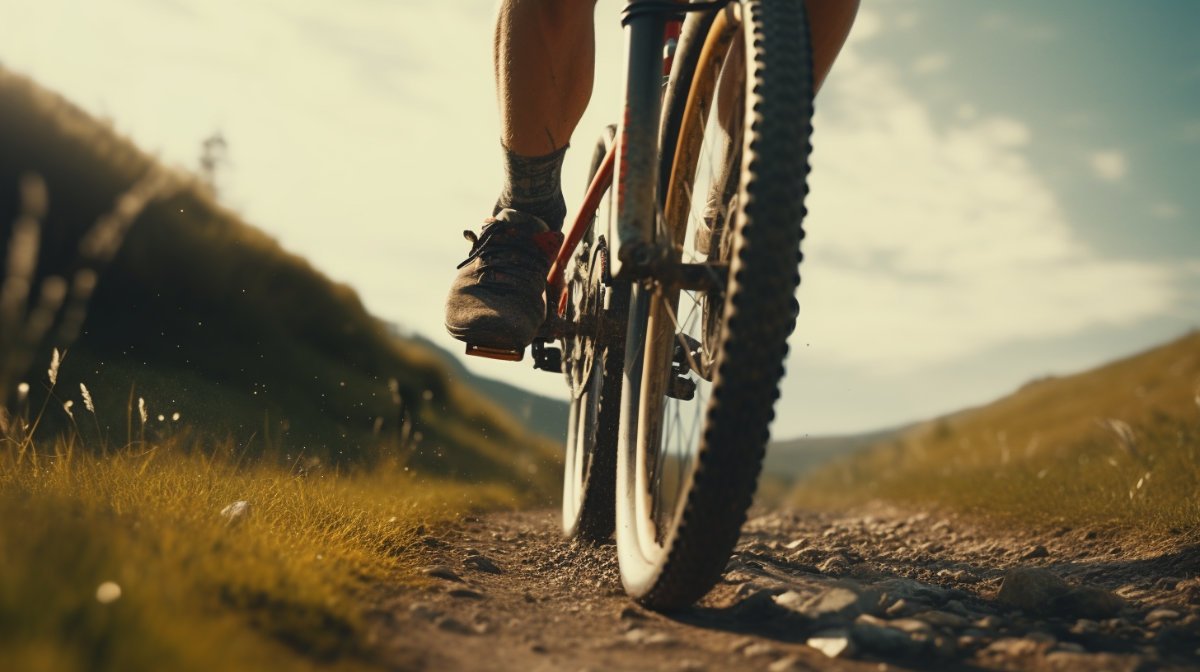Shin Splints from Biking: Understanding & Preventing
Biking is a fantastic way to stay active and enjoy the great outdoors. However, it’s not uncommon for cyclists to experience shin splints, which can put a damper on your cycling adventures. Shin splints, or shin and lower leg pain, can occur when you bike without proper training or push yourself too hard on hilly terrain. But fear not! With the right knowledge and preventive measures, you can continue biking without the discomfort of shin splints.
Shin Splints from Biking – Key Takeaways:
- Shin splints can occur in cyclists, especially if they engage in high-intensity biking without proper training.
- Overuse, improper rest, high gears, and improper saddle position can contribute to the development of shin splints.
- Treating shin splints in cycling can involve home remedies such as using ice packs and massaging the shins, but it’s crucial to consult a doctor if the pain persists or worsens.
- Preventing shin splints in cycling can be achieved by stretching, wearing proper footwear, using orthotics, performing lower leg exercises, and listening to your body.
- Understanding the impact of biking on the lower leg and the importance of exercises targeting the tibialis anterior muscle can help prevent and alleviate shin splints.
Causes of Shin Splints in Cycling
In the world of cycling, shin splints can be a frustrating and painful condition. Understanding the causes of shin splints is key to preventing and addressing this issue. In cycling, shin splints can be attributed to several factors, including overuse, improper rest, high gears, improper saddle position, stress fractures, and anterior compartment syndrome.
Overuse and Improper Rest
One of the main causes of shin splints in cycling is overuse. Pushing your body too hard, riding long distances without proper rest, or increasing your training intensity too quickly can put excessive strain on your shins. It is crucial to allow your body enough time to recover and adapt to the physical demands of cycling.
High Gears and Improper Saddle Position
Using high gears while cycling, especially on hilly terrain, can contribute to the development of shin splints. The added resistance places extra stress on your leg muscles, including your shins. Similarly, having an improper saddle position, such as setting it too high or too far forward, can lead to biomechanical imbalances and increased pressure on the shins.
Stress Fractures and Anterior Compartment Syndrome
Shin splints in cycling can also be caused by more severe conditions such as stress fractures and anterior compartment syndrome. Stress fractures are small cracks in the bone that result from repetitive impact and high force activities. Anterior compartment syndrome occurs when the muscles in the front of the lower leg swell within their sheath, causing pain and discomfort.
| Cause | Description |
|---|---|
| Overuse | Excessive strain on the shins due to prolonged or intense cycling without proper rest. |
| Improper Rest | Inadequate recovery time between rides, preventing the shins from fully healing. |
| High Gears | Riding in high gears, especially on hilly terrain, increases the strain on the shins. |
| Improper Saddle Position | An incorrect saddle position can create biomechanical imbalances and excessive pressure on the shins. |
| Stress Fractures | Small cracks in the bone due to repetitive impact and high force activities. |
| Anterior Compartment Syndrome | Swelling of the muscles in the front of the lower leg, causing pain and discomfort. |
By understanding these causes, cyclists can take proactive measures to prevent shin splints and ensure an enjoyable riding experience. It is important to address any discomfort or pain promptly and consult with a healthcare professional if needed. In the next section, we will explore various treatments for shin splints in cycling.
Treating Shin Splints in Cycling
Shin splints can be a painful and frustrating condition for cyclists. Fortunately, there are several effective home treatments that can help alleviate the discomfort and promote healing. One of the simplest and most accessible treatments is applying an ice pack to the affected area for 15-20 minutes at a time, several times a day. The cold temperature helps reduce inflammation and numb the pain. Additionally, gentle massages can help increase blood flow to the muscles, promoting healing and reducing muscle tension. You can use your fingers or a foam roller to massage the shins gently.
In some cases, over-the-counter pain relievers like ibuprofen can be helpful in managing shin splint discomfort. However, if the pain persists, is severe, or interferes with your daily activities, it’s important to consult with a doctor for a proper diagnosis and personalized treatment plan. Resting and elevating your legs can also provide relief and help prevent further aggravation of the shin splints. Take a break from cycling and avoid any activities that put strain on your shins until the pain subsides.
Proper footwear plays a crucial role in preventing and treating shin splints. Investing in cycling shoes that provide good support and cushioning can help reduce the impact on your shins. Additionally, incorporating regular stretching exercises into your routine can help improve flexibility and reduce muscle tightness. Focus on stretching the calf muscles and the front of your lower leg, where the shin splints occur. Using orthotic inserts inside your shoes can also provide additional support and help relieve pressure on the shins.
| Treatment | Description |
|---|---|
| Ice Pack | Apply an ice pack to the affected area for 15-20 minutes several times a day to reduce inflammation and numb the pain. |
| Massage | Gently massage the shins with your fingers or a foam roller to increase blood flow and promote healing. |
| Ibuprofen | Take over-the-counter pain relievers like ibuprofen to manage discomfort. Consult with a doctor if the pain persists or worsens. |
| Rest | Avoid activities that aggravate the shin splints and take a break from cycling to allow for healing. |
| Elevation | Resting with your legs elevated can help reduce swelling and promote healing. |
| Proper Footwear | Invest in cycling shoes that provide good support and cushioning to reduce the impact on your shins. |
| Stretching | Incorporate regular stretching exercises into your routine, focusing on the calf muscles and the front of the lower leg. |
| Orthotics | Use orthotic inserts inside your shoes to provide additional support and relieve pressure on the shins. |
By following these home treatments and taking the necessary precautions, you can effectively manage shin splints and get back to enjoying your cycling adventures pain-free.
Prevention of Shin Splints in Cycling
To prevent shin splints in cycling, it is important to take certain measures to protect your shins and lower legs. Here are some key strategies:
Stretching:
Before hopping on your bike, make sure to stretch your shins and lower legs. Focus on exercises that target the tibialis anterior muscle, such as toe raises and ankle circles. These stretches can help warm up the muscles and improve their flexibility, reducing the risk of shin splints.
Proper Footwear:
Investing in cycling shoes that provide good support and cushioning is crucial for preventing shin splints. Look for shoes with stiff soles and secure closures to minimize excessive movement and pressure on your shins. Additionally, consider using orthotics or insoles that provide extra arch support and shock absorption.
Lower Leg Exercises:
Strengthening your lower leg muscles can significantly reduce the risk of shin splints. Incorporate exercises such as calf raises, toe taps, and shin stretches into your regular workout routine. By building up the strength and endurance of these muscles, you can better withstand the demands of cycling.
Listening to Your Body:
One of the most important aspects of preventing shin splints is listening to your body. Pay attention to any discomfort or pain in your shins while cycling and take immediate action. If you experience persistent or worsening pain, it may be a sign that you need to rest or seek medical advice. Pushing through the pain can lead to more severe injuries and prolonged recovery periods.
By following these prevention strategies, you can greatly reduce the risk of developing shin splints while cycling. Remember, taking proactive steps to protect your shins and lower legs is essential for enjoying pain-free rides and maintaining your cycling routine.
Understanding Shin Splints in Cycling
Shin splints can be a bothersome issue for cyclists, causing pain and discomfort in the lower leg area. When it comes to cycling, the impact on the lower leg and the neglect of certain muscles can contribute to the development of shin splints. One particular muscle that is often overlooked is the tibialis anterior, which is responsible for lifting the toes up.
Many cyclists focus on the larger muscles in their legs, such as the quadriceps and hamstrings, but neglecting the front of the lower leg can lead to imbalances and increased strain on the shins. This can result in shin pain during cycling activities.
To prevent and alleviate shin splints, it is important to include exercises that target the tibialis anterior muscle in your training routine. One effective exercise is tibialis raises, which involve sitting on a bench or chair with your feet flat on the ground. Gradually lift your toes up while keeping your heels planted, and then lower them back down. Repeat this exercise for several sets, gradually increasing the repetitions as your strength improves.
By incorporating tibialis raises and other exercises that target the front of the lower leg into your training routine, you can strengthen the muscles in that area and reduce the risk of developing shin splints. Remember to listen to your body and seek guidance from a healthcare professional if you experience persistent or severe pain. Taking care of your lower leg muscles will help you enjoy your cycling adventures without the discomfort of shin splints.
| Exercise | Description | Repetitions |
|---|---|---|
| Tibialis Raises | Sit on a bench or chair with feet flat on the ground. Lift toes up while keeping heels planted, then lower them back down. | 3 sets of 10 repetitions |
| Toe Taps | Stand with feet hip-width apart and lift one foot off the ground, tapping the toes on the ground in front of you. Alternate legs. | 3 sets of 12 repetitions per leg |
| Ankle Dorsiflexion Stretch | Sit on the edge of a chair with one foot on the ground and the other foot extended in front. Flex the ankle of the extended foot, pointing the toes towards your body. | Hold for 30 seconds, 3 times per leg |
Conclusion
If you’re a cyclist who has experienced shin splints, don’t worry – there are ways to manage and prevent them. By understanding the causes of shin splints in cycling, such as overuse and improper rest, you can take steps to avoid these pitfalls.
When it comes to treating shin splints, home remedies like using ice packs, massaging the affected area, and taking pain relievers can provide some relief. However, it’s important to consult a doctor if the pain persists or worsens.
To prevent shin splints from recurring, incorporating stretching exercises, investing in proper footwear with good support and cushioning, and using orthotics can make a significant difference. Additionally, performing lower leg exercises and listening to your body’s signals for rest and recovery are key to maintaining healthy shin muscles.
By implementing these preventive measures and being mindful of your body, you can continue to enjoy biking without the discomfort of shin pain. Stay proactive and take care of your shins, so you can keep pedaling on the open road!
Shin Splints from Biking – FAQ
Can biking cause shin splints?
Yes, shin splints can occur in cyclists, especially if they increase their cadence or ride on hilly terrain without proper training.
Why do my shins hurt after cycling?
Shin splints in cycling can be caused by overuse, lack of proper rest between rides, riding in high gears, or having an improper saddle position.
How can I treat shin splints from biking at home?
Home treatments for shin splints in cycling include applying ice packs, massaging the shins, taking ibuprofen for pain and inflammation. If the pain persists or is severe, it is important to consult a doctor.
How can I prevent shin splints in cycling?
To prevent shin splints in cycling, it is important to stretch the shins and lower legs before riding, wear shoes with good support and cushioning, use orthotics, and perform lower leg exercises to strengthen the muscles. It is also crucial to listen to the body and rest when experiencing pain.
What is the cause of shin splints in cycling?
Shin splints in cycling can be caused by excessive impact on the lower leg and the overuse of the tibialis anterior muscle, which is responsible for lifting the toes up. Neglecting this muscle can lead to shin pain while cycling.







